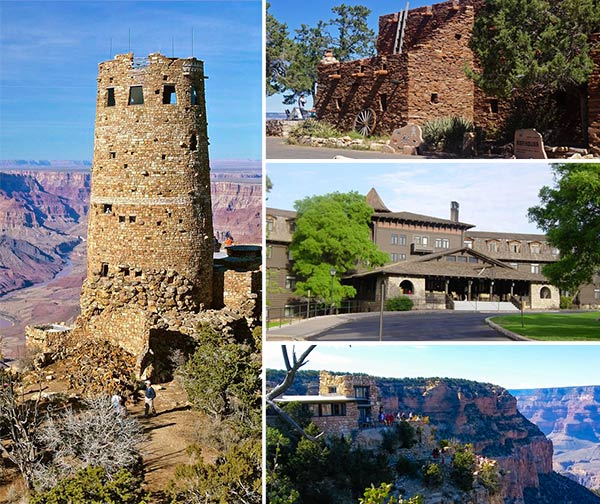Grand Canyon Historic Landmarks
Of course, the biggest draw of the Grand Canyon is the geological wonder itself. However, the historic landmarks
around the region make for an interesting vacation in their own right. From ancient Native American settlements
to early 20th century mule stables, these Grand Canyon historic landmarks are sure to catch your eye and will
make for a great vacation photo slideshow.
Desert View Watchtower
The 70-foot-tall stone tower overlooks the pristine North Rim of the Grand Canyon. The National Historic Landmark,
modeled after ancient Pueblo structures, was designed by architect Mary Colter, who also designed a number of
buildings within the national park. Completed in 1932, the interior is embellished with murals painted by
celebrated Hopi painter Fred Kabotie. Colter also incorporated Claude glass within the design, affording visitors
more abstract views of the canyon. In 1987, the tower and nearby support structures also designed by Colter were
designated by the United States as a National Register of Historic Places historic district.

- Hopi House
This unique attraction at the South Rim opened just two weeks before neighboring
El Tovar Hotel did in 1905. The property, modeled after traditional Hopi pueblos, has sold Native American
arts and crafts for more than 110 years. Architect Mary Colter also designed this beautiful building. You'll
find a large selection of native arts and crafts available for purchase, such as hand-crafted kachinas,
jewelry, hand-woven Navajo rugs and authentic Native American pottery.
- Lookout Studio
Another of Colter's masterpieces, Lookout Studio, along with Hopi House,
was designated as a National Historic Landmark by the federal government in 1987. It was constructed by the
Santa Fe Railroad in 1914 as a photography studio. The lower viewing platform offers visitors an intimate
glimpse at the Grand Canyon thanks to its multiple telescopes and large window banks.
- El Tovar Hotel and Stables
This timeless property, built of local limestone and Oregon
pine, has welcomed guests to the Grand Canyon's South Rim since opening its doors back in 1905. The Swiss
chalet-inspired masterpiece is the product of Chicago architect Charles Whittlesey and has hosted the likes
of Theodore Roosevelt, Albert Einstein, Western author Zane Grey, President Bill Clinton and Sir Paul
McCartney. Not one of the 78 rooms are the same, making each stay a unique one. The stables, built the
same year, continue to house the mules used to transport visitors and supplies to Phantom Ranch on the
canyon floor. Both structures received National Historic Landmark designation in 1987.
Grand Canyon Railway
Since its inception in 1901, the Grand Canyon Railway has captivated
millions of visitors to the natural wonder. Originally constructed as a means of transporting ore from the
Anita Mines, the railway today transports canyon explorers around the national park. Its 65 miles of track and
65 bridges dating back to 1900 meander from Williams, Ariz., north toward the South Rim. Luxury dining cars,
staged train robberies and majestic wildlife only add to the bucolic splendor of traveling across this stunning
region just as they did a hundred years ago.
Tusayan Ruins
This 800-year-old Pueblo Indian settlement is considered one of the most important
archeological sites in the entire region. There is a trail that runs through the ruins and a small museum
featuring interpretive exhibits. Explore the small settlement's plaza, ceremonial "kiva," grain storage areas,
marketplace and farm area. Visitors will also appreciate the panoramic views of the San Francisco Peaks in the
distance.
Navajo Bridge
Navajo Bridge crosses the Colorado River in Marble Canyon near Lee's Ferry at
the eastern portion of the Grand Canyon. This 834-foot steel spandrel bridge was constructed between 1927 and
1929 through a joint effort by the Arizona State Highway Commission, the United States Department of the
Interior's Bureau of Indian Affairs and the Navajo Nation. It is still open to pedestrian and equestrian use.
You might also see bungee jumpers utilizing the span. The structure was placed on the National Register of
Historic Places in 1981.
Hermit's Rest
This rest area for tourists exploring the park opened in 1914. Designed by none
other than Mary Colter, the rustic structure is partly buried in an earth mound and was intended to resemble
a natural rock formation. It marks the western terminus of the Rim Trail and was named after Canadian-born miner,
explorer and hermit Louis Boucher who lived in the canyon alone during the late 19th century. Be sure to
purchase some freshly baked cookies.